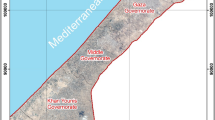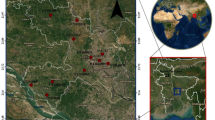Abstract
To control land subsidence due to groundwater withdrawal, it is important to estimate allowable withdrawn volume of groundwater in a soft deposit. This technical note presents a simple approach for estimating the allowable withdrawn volume of a deposit. A regression analysis method was used based on measured land subsidence and recorded net withdrawn volume. This approach was proposed based on the principle of soil compression at different effective stresses, i.e. the soil compression is small when the consolidation stress is lower than the yield stress of the deposit, but large when the consolidation stress is higher than the yield stress. Two case studies are presented in this technical paper to demonstrate how to use the simple approach to estimate the allowable withdrawn volume.





Similar content being viewed by others
References
Chai JC, Shen SL, Zhu HH, Zang XL (2004) Land subsidence due to groundwater drawdown in Shanghai. Géotechnique 54(2):143–147. doi:10.1680/geot.54.2.143.36332
Chen JJ, Zhang LY, Zhang JF, Zhu YF, Wang JH (2013) Field tests, modification and application of deep soil mixing (DSM) method in soft clay. J Geotech Geoenviron Eng 139(1):24–34. doi:10.1061/(ASCE)GT.1943-5606.0000746
Foster SSD, Morris BL, Lawrence AR, Chilton J (1999) Groundwater impacts and issues in development cities: an introductory review. In: Chilton J (ed) Groundwater in the urban environment: selected city profile. Balkema, Rotterdam, The Netherlands, pp 3–18
Galloway D, Jones DR, Ingebritsen SE (1999) Land subsidence in the United States. U.S. Geological Survey circular 1182
Gambolati G, Teatini P, Ferronato M (2006) Anthropogenic land subsidence. Earth Sci Frontiers 13(1):160–178. doi:10.1002/0470848944.hsa164b
Holzer TL, Bluntzer RL (1984) Land subsidence near oil and gas fields, Houston, Texas. Ground Water 22(4):450–459
Horpibulsuk S, Miura N, Koga H, Nagaraj TS (2004) Analysis of strength development in deep mixing: a field study. Ground Improv 8(2):59–68. doi:10.1680/grim.8.2.59.36367
Horpibulsuk S, Rachan R, Suddeepong A, Chinkulkijniwat A (2011) Strength development in cement admixed Bangkok clay: laboratory and field investigations. Soils Found 51(2):239–251. doi:10.3208/sandf.51.239
Horpibulsuk S, Phochan W, Suddeepong A, Chinkulkijniwat A, Liu MD (2012) Strength development in blended cement admixed saline clay. Appl Clay Sci 55:44–52. doi:10.1016/j.clay.2011.10.003
Huang J, Han J (2009) 3D coupled mechanical and hydraulic modeling of a geosynthetic-reinforced deep mixed column-supported embankment. Geotext Geomembr 27(4):272–280. doi:10.1016/j.geotexmem.2009.01.001
Huang Y, Jiang XM (2010) Field-observed phenomena of seismic liquefaction and subsidence during the 2008 Wenchuan earthquake in China. Nat Hazards 54(3):839–850. doi:10.1007/s11069-010-9509-6
Huang Y, Dai ZL, Zhang WJ, Chen ZY (2011a) Visual simulation of landslide fluidized movement based on smoothed particle hydrodynamics. Nat Hazards 59(3):1225–1238. doi:10.1007/s11069-011-9859-8
Huang Y, Zhang WJ, Mao WW, Jin C (2011b) Flow analysis of liquefied soils based on smoothed particle hydrodynamics. Nat Hazards 59(3):1547–1560. doi:10.1007/s11069-011-9851-3
Ministry of the Environment in Japan (MEJ) (2008) Outline of land subsidence in the whole country in 2007 (in Japanese)
Miyabe N (1969) Directions of research on land subsidence. In: Land subsidence, proceeding of the Tokyo Symposium, Tokyo, Japan, pp 1–11
Peng FL, Wang HL, Tan Y, Xu ZL, Li YL (2011) Field measurements and finite-element method simulation of a tunnel shaft constructed by pneumatic caisson method in Shanghai soft ground. J Geotech Geoenviron Eng ASCE 137(5):516–524. doi:10.1061/(ASCE)GT.1943-5606.0000460
Pokrovsky DS, Rogov GM, Kuzevanov KI (1999) The impact of urbanization on the hydrogeological conditions of Tomsk, Russia. In: Chilton J (ed) Groundwater in urban environment: selected city profiles. Balkema, Rotterdam, The Netherlands, pp 217–223
Poland JF (1984) Guidebook to studies of land subsidence due to ground-water withdrawal. Published by the United Nations Educational, Scientific and Cultural Organization
Shanghai Geological Environmental Atlas Editorial Board (SGEAEB) (2002) Shanghai geological environmental atlas (SGEA). Geology Press, Beijing, China
Shanghai Geology Office (SGO) (1979) Report on land subsidence in Shanghai (1962–1976) (in Chinese)
Shen SL, Xu YS (2011) Numerical evaluation of land subsidence induced by groundwater pumping in Shanghai. Can Geotech J 48(9):1378–1392. doi:10.1139/t11-049
Shen SL, Tohno I, Nishigaki M, Miura N (2004) Land subsidence due to withdrawal of deep-groundwater. Lowl Technol Int 6(1):32–43
Tan Y, Lan HL (2012). Investigation of vibration effects due to driving of PHC pipe piles. J Perform Constr Facil ASCE 26(5). doi:10.1061/(ASCE)CF.1943-5509.0000278
Tan Y, Li MW (2011) Measured performance of a 26 m deep top-down excavation in downtown Shanghai. Can Geotech J 48(5):704–719. doi:10.1139/t10-100
Tan Y, Wei B (2012a) Observed behavior of a long and deep excavation constructed by cut-and-cover technique in Shanghai soft clay. J Geotech Geoenviron Eng 138(1):69–88. doi:10.1061/(ASCE)GT.1943-5606.0000553
Tan Y, Wei B (2012b) Performance of an over-excavated metro station and facilities nearby. J Perform Constr Facil ASCE 26(3):241–254. doi:10.1061/(ASCE)CF.1943-5509.0000231
Terzaghi K, Peck RB (1948) Soil mechanics in engineering practice. Wiley, New York
Wang HG (2006) Current situation and tendency of land subsidence in Tianjin. Master dissertation, China University of Geosciences, Beijing, China (in Chinese)
Xu YS, Shen SL, Cai ZY, Zhou GY (2008) The state of land subsidence and prediction approaches due to groundwater withdrawal in China. Nat Hazards 45(1):123–135
Xu YS, Shen SL, Du YJ (2009) Geological and hydrogeological environment in shanghai with geohazards to construction and maintenance of infrastructures. Eng Geol 109(3–4):241–254
Xu YS, Ma L, Du YJ, Shen SL (2012a) Analysis on urbanization induced land subsidence in Shanghai. Nat Hazards 63(2):1255–1267. doi:10.1007/s11069-012-0220-7
Xu YS, Ma L, Shen SL, Sun WJ (2012b) Evaluation of land subsidence by considering underground structures penetrated into aquifers in Shanghai. Hydogeol J 20(8):1623–1634. doi:10.1007/s10040-012-0892-9
Yin ZY, Chang CS (2011) Stress-dilatancy behavior for sand under loading and unloading conditions. Int J Numer Anal Methods Geomech. doi:10.1002/nag.1125
Yin ZY, Xu Q, Chang CS (2012) Modeling cyclic behavior of clay by micromechanical approach. ASCE J Eng Mech, Published Online. doi:10.1061/(ASCE)EM.1943-7889.0000516
Acknowledgments
The research work described herein was funded by the National Nature Science Foundation of China (NSFC) (Grant No. 41102175). This work is also funded by the Open Foundation Project of the State Key Laboratory of Geohazard Prevention and Geoenvironment Protection (Grant No. SKLGP2012K029). It is also supported by the starting funding of young faculty members of Shanghai Jiao Tong University. These financial supports are gratefully acknowledged.
Author information
Authors and Affiliations
Corresponding author
Rights and permissions
About this article
Cite this article
Xu, YS., Huang, RQ., Han, J. et al. Evaluation of allowable withdrawn volume of groundwater based on observed data. Nat Hazards 67, 513–522 (2013). https://doi.org/10.1007/s11069-013-0576-3
Received:
Accepted:
Published:
Issue Date:
DOI: https://doi.org/10.1007/s11069-013-0576-3




